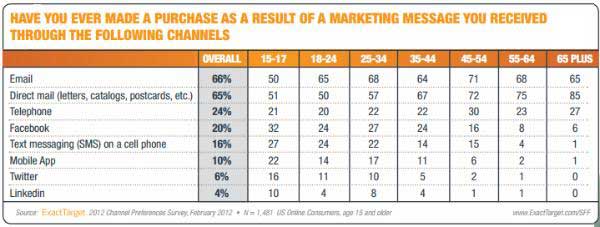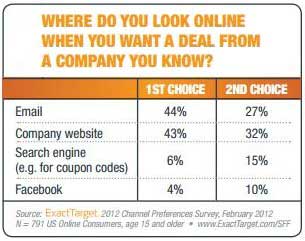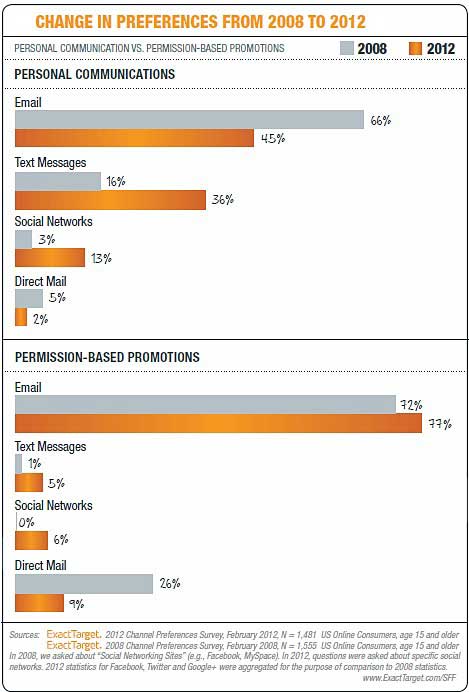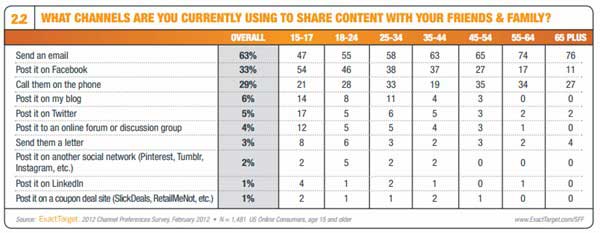Email remains a powerful way to connect with customers and influence their buying decisions: 66% of online Americans say they have made a purchase as a result of an email from a brand, more than three times the percentage of people who have purchased in response to a message delivered via Facebook (20%) or text message (16%), according to a study by Exact Target.
Direct mail is also a key tool for motivating consumers to buy: 65% of surveyed online Americans say they have made a purchase in response to message received via direct mail. By contrast, mobile apps (10%) and social channels such as Twitter (6%) and LinkedIn (4%) are less likely to influence consumers' buying decisions.

Brand messages via social channels tend to sway younger generations: Teens (age 15-17) are the most likely to be influenced by brand messages delivered via Facebook (32%) and Twitter (16%) when making purchases.
Below, additional findings from Exact Target's 2012 Channel Preferences Survey.
Finding Deals
Even when seeking deals, consumers tend to prefer email (44%), followed by brand websites (43%), search engines (6%) and Facebook (4%).

Ask to name their second choice for finding deals, company websites top the list (32%), followed by email (27%), search engines (15%) and Facebook (10%).
Email Favored for Permission-Based Messages
More than three-quarters (77%) of consumers prefer email for permission-based marketing messages. Direct mail is a distant second (9%), followed by text messaging (5%), Facebook (4%), and telephone calls (2%).
Email is preferred even among teens (66%) over all other direct channels for permission-based marketing communications.
Changes in Preferences
Preferences for permission-based communications haven't changed much over the past few years.
In 2008, email was the top permission-based communications channel for 72% of consumers (vs. 77% in 2012).

However, consumers' preferences for personal communications have shifted dramatically, in favor of social networks and text messaging:
- 45% now use email for personal communications, down from 66% in 2008.
- 36% use text messaging for such communications, up from 16%.
- 13% use social networks for personal communications, up from 3%.
Sharing Content
Such shifts in preferences are also reflected in the way people, particularly younger generations, share content with friends and family.
Email is the most popular content sharing channel, even beating Facebook by 30 percentage points (63% vs. 33%). Younger people are less likely than their older counterparts to share content via email; however, teens are the only age segment that shares more content via Facebook than email (54% vs. 47%).

Frequency of Engagement
Email and Facebook are the channels most frequently used among online consumers:
- 96% use email at least weekly.
- 70% use Facebook at least weekly.
- 20% use Twitter at least weekly.
Customer Service Communications
Among online consumers, email is also favored for resolving customer service issues, and for financial and travel alerts:
- When receiving customer service messages, 76% prefer email, whereas 10% prefer direct mail, 4% prefer telephone, and 4% prefer Facebook.
- For financial (banking) alerts, 52% prefer email messages, whereas 18% prefer telephone calls and 15% prefer text messages.
- For travel alerts, 43% prefer email messages, whereas 25% prefer text messages and 18% prefer telephone calls.
About the data: Findings are based on a survey of 1,481 Americans age 15 and over, conducted by Exact Target from January 27 to February 1, 2012.



